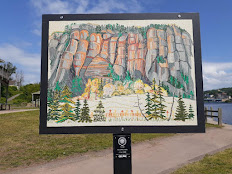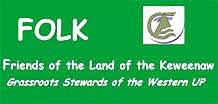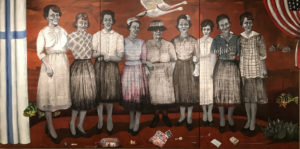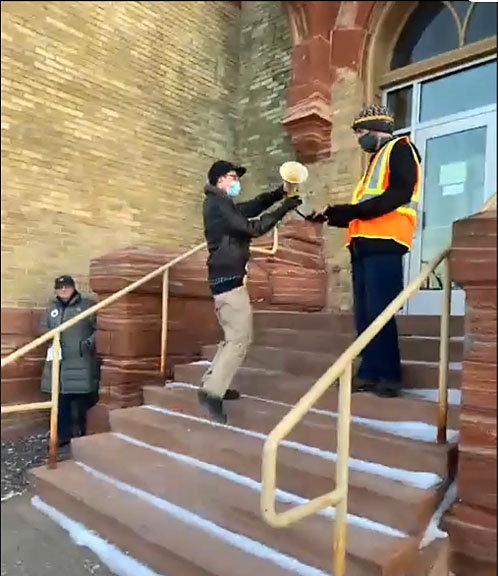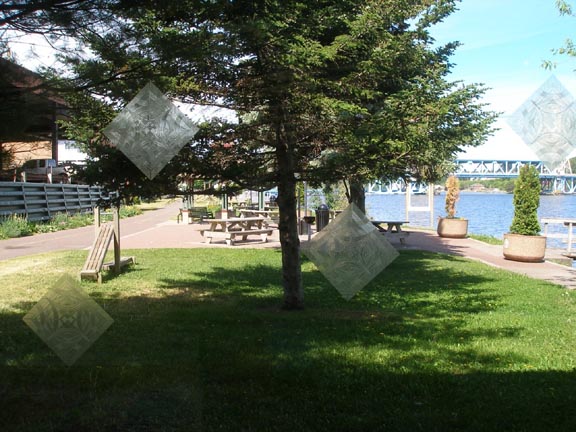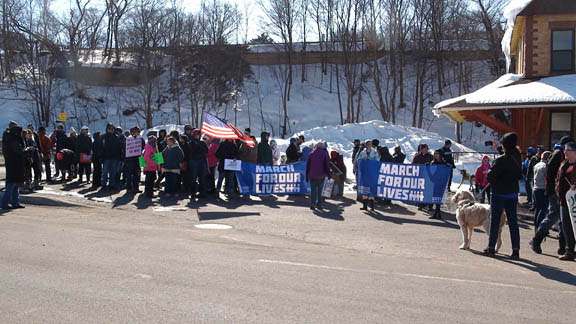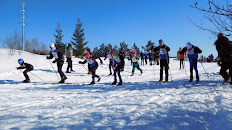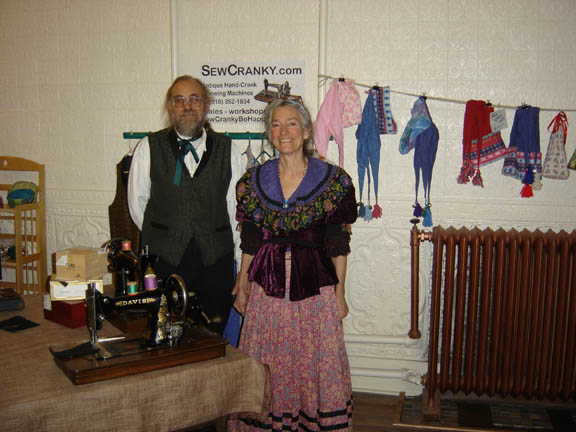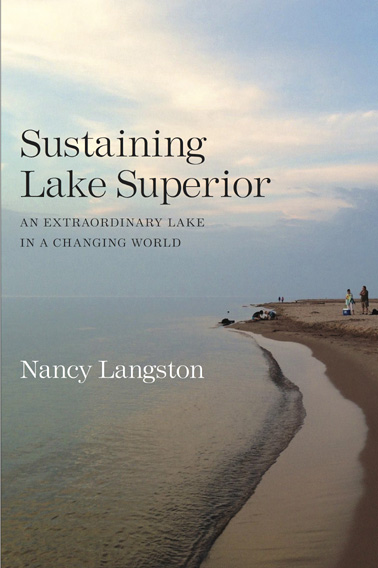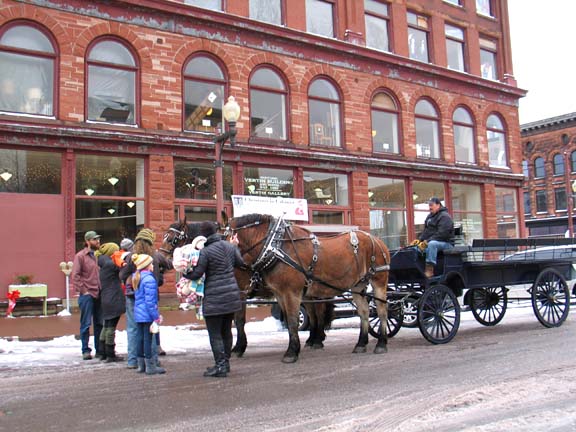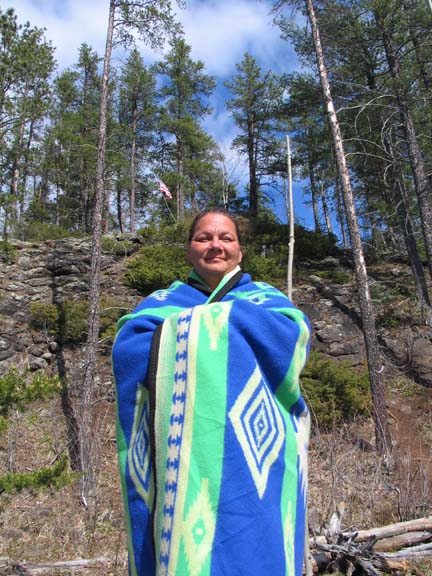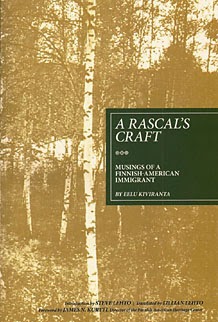Dec. 20, 2019, Press Release
Female Wolf at Night. Trail camera photo of the first female wolf released on Isle Royale. Captured 9-27-18. (Photo courtesy National Park Service)
HOUGHTON -- The National Park Service (NPS) and research partners from the State University of New York – College of Environmental Science and Forestry (SUNY-ESF) are using data from GPS collars on introduced wolves to monitor associations between individuals and identify possible pack formation. As researchers and NPS staff anticipated, new wolves immediately began interacting with each other. Researchers confirmed introduced wolves were feeding, traveling, sleeping in proximity to each other, and forming groups.
A trail camera photo of the first male wolf relocated to Isle Royale dragging off food. (Photo courtesy National Park Service)
A wolf "group" is characterized by two or more wolves traveling and feeding together. Wolf groups are further defined as a "pack" if groups of two or more wolves are traveling together and/or defending a territory, and if a breeding pair reproduces. Individual preferences for mating and group or pack formation can be quite variable for a social animal like the wolf. Mate selection and pair bond formation can occur at any time, but wolves only breed and produce pups once per year. Consequently, pack formation can take time. Based on these definitions, there are currently no wolf packs on Isle Royale.
Staff unloads a wolf in a crate from the seaplane on Oct. 4, 2018. (Photo by Jim Peaco and courtesy National Park Service)
GPS collar data shows three wolves, 1 female and 2 males, have been traveling, feeding, and bedding together since March, 2019 (W001F, W007M, and W013M). This is the first wolf group to form and remain associated since introduction efforts began. Additionally, two male wolves shared bed sites and carcasses over the summer with several different female wolves, but their associations lack consistency and are currently not defined as wolf groups. Two female wolves shared bed site areas over the summer (July), but are also not considered a group. Loose associations are common when smaller prey items like moose calves, beaver and snowshoe hare are abundant on the landscape. These animals are easy prey for a single wolf.
Dr. Jerry Belant, Campfire Conservation Fund Professor at SUNY-ESF and project collaborator, said, "Wolves are a highly social species and we continue to monitor their movements to document groups, and ultimately pack formations as demonstrated by reproduction. We developed a public online tool, https://belantlab.shinyapps.io/wolf-networks/ based on these analyses to understand potential associations among these wolves and the areas they occupy."
From left, Ashley Lutto, a research associate with the State University of New York’s College of Environmental Science and Forestry; National Park Service veterinarian Michelle Verant; Michigan Department of Natural Resources (DNR) veterinary specialist Dan O’Brien; and Michigan DNR wildlife technician Brad Johnson collect and record data on a gray wolf captured Sept. 8, 2019, in Michigan’s Upper Peninsula. (Photo courtesy John Pepin, Michigan DNR)
Researchers monitoring the GPS collar signals identified two wolf mortality events this fall. In September, researchers and NPS staff detected a mortality signal and recovered the remains of female W004F. Field evidence and subsequent necropsy at the U.S. Geological Survey National Wildlife Health Center in Madison, Wis., determined W004F died from wounds caused by another wolf or wolves. In October just prior to island closing, NPS staff came across the remains of male wolf, M183, one of the two remaining uncollared resident wolves inhabiting Isle Royale prior to introduction efforts. Necropsy revealed that M183 had also been killed by another wolf or wolves. These events are not uncommon as wolves defend and establish their territories and social hierarchy. With many wolves on the island sorting out their relationships with one another, the dynamic nature of wolf social organization, territoriality, and wolf-on-wolf aggression during group and pack formation is not unexpected.
Rolf Peterson, research professor at Michigan Technological University and long-time wolf and moose investigator on Isle Royale, commented on the death of M183, one of the two remaining uncollared resident wolves inhabiting Isle Royale prior to introduction of the new wolves.
"With the death of the island-born male, travel patterns of the remaining wolves are likely to change significantly, and probably dependent on whether or not the island-born female is still alive, whether she is territorial and how she gets along with the newcomers, both males and females," Peterson said. "She is the final native wolf, never radio-collared; and searching for her will be a priority during the upcoming winter study."
Summer wolf location cluster investigations documented 122 instances of two or more wolves with overlapping space use. Twenty-nine cases (23.8 percent) of space use overlap were associated with prey remains and feeding behavior, 68 percent were associated with bed sites, and wolf use for the remaining 7.4 percent of sites was unknown or could not be determined.
Researchers continue to monitor location data weekly for evidence the three newest wolves, released on the island in September 2019, are adjusting to their new homes, interacting and forming associations. These wolves are interacting with each other (W017M and W018F were traveling together in late November) and with the wolves released last spring (W018F and W016M traveled together in early November).
NPS and its collaborators will continue to monitor the interactions, group formation, and genetic diversity of new wolves over winter and spring to document breeding (January/February) and denning (April/May) activity in Isle Royale’s wolf population. Closely monitoring social organization will provide insights into the genetic health of the population. The NPS has partnered with Dr. Kristin Brzeski, wildlife geneticist at Michigan Tech, to sequence the Isle Royale wolf genome for long-term monitoring of genetic health of the population.
"We have a unique opportunity to look simultaneously at the past and future of Isle Royale wolves’ genetic health," said Dr. Brzeski. "With the death of M183, we can now more fully understand how genetic isolation and inbreeding impacted the historic wolf population and use that to better monitor the new founders. This is an exciting time and we will be using cutting-edge genetic tools to track reproduction, inbreeding, and genetic change through time, hopefully providing a piece of the puzzle for maintaining a thriving Isle Royale wolf population."
According to Mark Romanski, NPS project coordinator and Division Chief of Natural Resources at Isle Royale, multiple lines of investigations regarding this population will help the NPS evaluate the success of the project over the next few years.
Fall 2019 First Wolf: Observation 6. Mark Romanski, Isle Royale National Parks’ division chief for natural resources and project leader for wolf relocation efforts, center, gets ready to record gray wolf information from Michigan DNR wildlife technician Brad Johnson, left, and Michigan DNR veterinary specialist Dan O’Brien. (Photo courtesy John Pepin, Michigan DNR)
"We are using everything we can in our toolbox to track how this population interacts with each other, prey and the landscape," Romanski noted. "We’ll continue to learn as much as we can moving forward to help with the decision to add wolves as needed to meet project objectives and document ecosystem effects."
The first wolf introductions on Isle Royale occurred in September 2018.
Isle Royale Superintendent Phyllis Green, left, and Ecologist Lynette Potvin prepare to open the crate to release the first new wolf relocated to Isle Royale in September 2018. (Photo courtesy John Pepin and National Park Service)
This video captures the first new wolf release:
Isle Royale Ecologist Lynette Potvin speaks about the first wolf release:
Inset photo: Rolf Peterson (File photo courtesy Michigan Tech University)
Editor's Note: Learn more about Isle Royale National Park by visiting their Web site.





















































